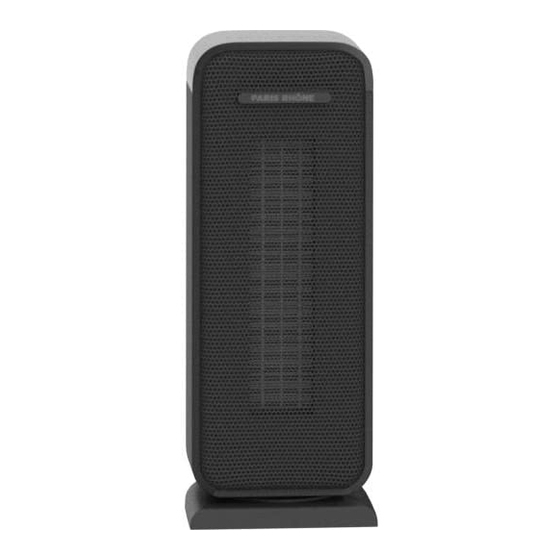
Advertisement
Quick Links
PTC FAN HEATER
PE-HE001
User Manual
IMPORTANT SAFETY INSTRUCTIONS
BEFORE USING THIS APPLIANCE READ ALL INSTRUCTIONS AND CAUTIONARY MARKINGS
IN YOUR USER MANUAL AND ON THE APPLIANCE
INTENDED USE
· This heater is not intended for use in bathroom, laundry areas and similar moist indoor
locations. Never locate heater where it may fall into a bathtub or other water container.
· Use this heater only as described in this manual. Any other use not recommended by the
manufacturer may cause fire, electric shock, or injury to persons.
· The output of this heater may vary and its temperature may become intense enough to burn
exposed skin. Use of this heater is not recommended for persons with reduced sensitivity to
heat or an inability to react to avoid burns.
ELECTRICAL SAFETY
· Do not run cord under carpeting. Do not cover cord with throw rugs, runners, or similar
coverings. Do not route cord under furniture or appliances. Arrange cord away from traffic
area and where it will not be tipped over.
· It is normal for the plug to feel warm to the touch; however, a loose fit between the AC outlet
(receptacle) and plug may cause overheating and distortion of the plug. Contact a qualified
electrician to replace loose or worn outlet.
· To disconnect the heater, first turn it off, then remove plug from outlet. Never pull by the cord.
· Always plug heaters directly into a wall outlet/receptacle. Never use with an extension cord or
reloadable power tap (outlet/power strip).
RELATED TO USE
· This heater is hot when in use. To avoid burns, do not let bare skin touch hot surface.
Keep combustible materials such as furniture, pillows, bedding, papers, clothes and curtains at
least 3 feet (0.9m) from the front of the heater.
· Extreme caution is necessary when this heater is used by or near children or invalids and
whenever the heater is left operating and unattended.
· Do not operate any heater with a damaged cord or plug or after the heater malfunctions, has
been dropped or damaged in any manner. Discard heater or return heater to authorized
service facility for examination, electrical or mechanical adjustment, or repair.
· Do not use the heater outdoors.
· To prevent a possible fire, do not block air intakes or exhausts in any manner.
· Do not use on soft surface, like a bed, where openings may become blocked.
· A heater has hot and arcing or sparking parts inside. Do not use it in the areas where gasoline,
paint, or flammable liquids are used or stored.
· Do not insert or allow foreign objects to enter any ventilation or exhaust opening as this may
cause an electric shock or fire, or damage the heater.
· Always unplug the heater when not in use.
· Never tamper with the heater or attempt to fix it. Any tampering with, or modification of this
product can result in serious injury, death, or fire, risk of electric shock. Do Not open. No user
serviceable parts inside.
· DO NOT remove product labels that contain warnings or safety instruction.
· Before cleaning, or storage, or when not in use, turn the heater off and unplug it.
READ ALL INSTRUCTIONS BEFORE
USING THIS HEATER.
SAVE THESE INSTRUCTIONS
Specifications
Input
120V~ 60Hz
Rated Power
1500W (High)
900W (Low)
Remote Control Battery
AAA 1.5V (not included)
Knowing Your Heater
Control Panel
Air Outlet
Display
Base
Advertisement

Subscribe to Our Youtube Channel
Summary of Contents for Paris Rhone PE-HE001
- Page 1 · Extreme caution is necessary when this heater is used by or near children or invalids and whenever the heater is left operating and unattended. PE-HE001 · Do not operate any heater with a damaged cord or plug or after the heater malfunctions, has been dropped or damaged in any manner.
- Page 2 Using Your Humidifier When ECO mode is turned on, the heater will adjust the working mode (High or Low) automatically based on the ambient temperature. On/Off Place the heater on a firm, level surface free from obstructions, and at least 3 ft (90 cm) away from any wall or combustible material.
- Page 3 尺寸: 120*160mm 材质: 128克铜版纸 折页...



Need help?
Do you have a question about the PE-HE001 and is the answer not in the manual?
Questions and answers
My nearly new, super-quiet-at-all-speeds, Paris Rhone tower fan suddenly sounds like a motorboat. I checked and there are no obvious obstructions impeding the fan's cylindrical blade. I thought I'd better check before trying to disassemble it. So disappointed w/this fan's sudden turn of events.
A Paris Rhone PE-HE001 tower fan could make a loud noise despite having no visible obstructions due to the following reasons:
1. Internal Dust or Debris – Dust buildup inside the unit could affect the fan's movement and cause noise.
2. Loose Components – Internal parts may have loosened over time, leading to vibrations or rattling sounds.
3. Fan Misalignment – The fan blades might be misaligned or slightly damaged, causing imbalance and noise.
4. Worn Bearings or Motor Issues – If the motor or bearings are worn out, they could produce grinding or humming sounds.
5. Improper Placement – Placing the heater on an uneven or soft surface may cause vibrations and noise.
Checking for dust, ensuring all parts are secure, and placing the unit on a stable surface may help reduce the noise.
This answer is automatically generated
What does error message P4 mean